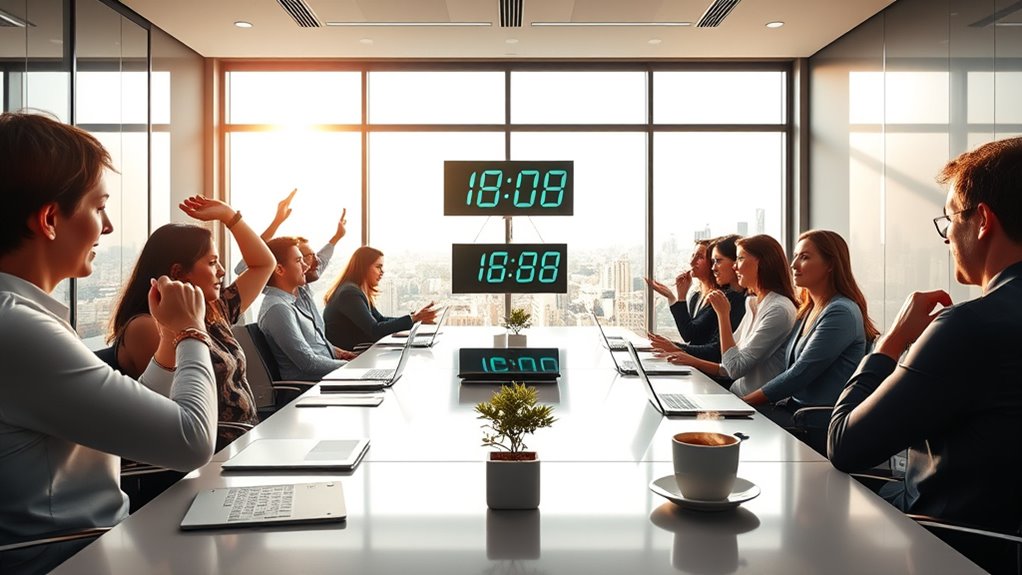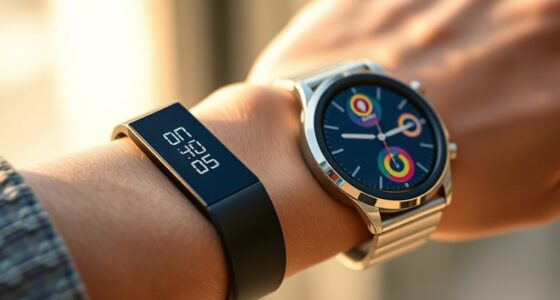Taking micro-breaks during long Monday meetings helps protect your focus by resetting neural activity and reducing mental fatigue. Short pauses of 1-5 minutes allow your brain to recover and stay engaged, preventing burnout and loss of concentration. Recognizing signals like eyestrain or restlessness can guide you to take effective breaks. Keep up with practical tips and strategies, and you’ll discover how small pauses can considerably boost your productivity.
Key Takeaways
- Micro-breaks reset neural activity, helping maintain sustained attention during lengthy meetings.
- Short pauses reduce mental fatigue, preventing decreased motivation and focus breakdown.
- Stretching and quick exercises during breaks improve circulation and reduce physical discomfort.
- Breaks promote mindfulness and relaxation, enhancing mental clarity and decision-making.
- Recognizing signs of fatigue early allows timely micro-breaks to prevent burnout and sustain engagement.
Understanding the Science Behind Micro-Breaks

Understanding the science behind micro-breaks reveals why they are effective for maintaining focus. Neuroscience insights show that your brain can only concentrate intensely for a limited time before fatigue sets in. During this period, neural activity related to attention diminishes, making it harder to stay engaged. Short breaks, typically lasting one to five minutes, help reset this neural activity, allowing you to recover mental clarity. Break duration is *fundamental*; too short, and your brain doesn’t get enough recovery, too long, and you risk losing momentum. By strategically timing these micro-breaks, you optimize your brain’s natural rhythms, preventing burnout and enhancing sustained attention. Effective use of break duration is crucial because it aligns with how the brain naturally recovers and maintains focus, supported by scientific research. Additionally, understanding neural recovery helps in designing optimal break schedules that maximize focus. Recognizing the importance of cognitive restoration can further refine how you plan these intervals for maximum benefit. For instance, incorporating neural fatigue management strategies can significantly improve your ability to sustain concentration. This scientific understanding underscores why incorporating brief, well-timed pauses is a proven method for maintaining focus during demanding tasks.
The Impact of Continuous Focus on Productivity and Well-Being

When you maintain prolonged periods of intense focus without taking breaks, both your productivity and well-being can suffer. You may notice increased mental fatigue, decreased motivation, and physical discomfort. Over time, this can lead to burnout and lower work quality. Incorporating mindfulness exercises helps reset your mental state, reducing stress and improving concentration. Ergonomic adjustments, like proper chair height or screen positioning, prevent physical strain. Without these strategies, your ability to sustain focus diminishes. Continuous focus also hampers creativity and decision-making. By contrast, regular micro-breaks allow your mind to reset, boost resilience, and maintain high performance. Recognizing the impact of sustained focus underscores the importance of integrating small, intentional pauses into your routine for long-term productivity and well-being. Additionally, practicing Comfort Solutions for Sofa Beds can enhance your overall comfort during work or relaxation breaks at home, supporting mental and physical health. Embracing ergonomic principles can further optimize your workspace, reducing discomfort and promoting sustained focus over extended periods. Incorporating proper lighting into your environment can also reduce eye strain and improve concentration during long meetings.
Practical Strategies for Incorporating Micro-Breaks Into Meetings

To keep meeting participants engaged and focused, incorporating micro-breaks strategically throughout the session is vital. You can do this by encouraging simple stretching routines every 20–30 minutes to reduce physical tension and boost circulation. Remind everyone to stay hydrated by sipping water during breaks, which helps maintain mental clarity. Use visual cues, like a slide or timer, to signal when a micro-break is due, making it easy to pause without disrupting flow. Incorporate quick exercises, such as neck rolls or shoulder shrugs, to refresh energy. These small pauses prevent fatigue and sustain attention. Additionally, integrating sustainable materials into meeting setups, such as eco-friendly stationery or reusable cups, aligns with environmentally conscious practices. Being mindful of celebrity lifestyle insights during planning can inspire more innovative and engaging meeting environments. It is also beneficial to consider proper planning and timing to ensure breaks are effective without extending the overall meeting duration. By intentionally scheduling these micro-breaks and emphasizing hydration and stretching routines, you create a more productive, comfortable meeting environment. Incorporating powerful persuasive words can also enhance engagement and encourage participation during these breaks.
Recognizing the Signs That You Need a Break

Have you ever noticed that your focus starts to drift or your body feels tense during a long meeting? Recognizing when you need a break is key to maintaining productivity. You might experience eye strain from staring at the screen too long or feel mental fatigue that clouds your thinking. Other signs include difficulty concentrating, frequent yawning, or a restless urge to move. If you find yourself rubbing your eyes or blinking excessively, it’s a clear cue your eyes require relief. Similarly, feeling mentally drained or overwhelmed indicates your brain needs a pause. Paying attention to these signals helps you take timely micro-breaks, preventing burnout and boosting focus for the remainder of the meeting. Understanding the importance of necessary cookies can help you optimize your online experience and maintain concentration. Listening to your body ensures you stay sharp and engaged.
Tips for Maximizing the Benefits of Short Pauses

Taking regular short breaks during work sessions can considerably enhance your focus and overall productivity. To maximize these benefits, incorporate mindfulness practices like deep breathing or brief meditation during your pauses to reset your mind. Additionally, use ergonomic tips such as adjusting your chair and screen height to prevent strain and promote comfort. During your break, stand up, stretch, or walk around to improve circulation and reduce fatigue. Avoid screens during these moments to give your eyes a rest. These small adjustments help you stay alert and prevent burnout throughout long meetings. Practicing mindfulness techniques during your micro-breaks can deepen your sense of calm and presence, further supporting mental clarity. Incorporating eye patch benefits into your routine can also help reduce eye strain and refresh your vision, making it easier to stay focused. Regularly practicing ergonomic habits can lead to better posture and fewer discomforts over time. Using micro-break strategies effectively can optimize your focus and energy levels during demanding work periods. Consistently practicing mindfulness and maintaining proper ergonomic habits during your micro-breaks ensures you return to work refreshed, focused, and ready to engage more effectively.
Frequently Asked Questions
How Long Should Each Micro-Break Last for Optimal Effect?
The question about break duration and ideal timing is important for maintaining focus. For micro-breaks, aim for about 1 to 2 minutes each—short enough to refresh without losing momentum. Take these breaks every 20 to 30 minutes during long meetings. This spacing helps you stay alert and productive, ensuring your focus doesn’t wane, and your attention remains sharp throughout the session.
Can Micro-Breaks Improve Team Communication During Meetings?
Imagine you’re in a meeting where micro-breaks are like the secret weapon of the 21st century. You can use these breaks to enhance team communication by encouraging eye contact and tone modulation. When you take a moment to pause, you give others space to express themselves more clearly. This small shift fosters better understanding, reduces misunderstandings, and keeps everyone engaged, turning long meetings into productive, collaborative sessions.
Are There Specific Activities Recommended During Micro-Breaks?
During micro-breaks, you should focus on simple activities like stretching exercises and quick mindfulness practices. Stretching helps relieve physical tension and boosts blood flow, while quick mindfulness sessions can clear your mind and reduce stress. These activities are easy to do at your desk and only take a few minutes, making them perfect for maintaining focus and energy during long meetings. Incorporate them regularly for better concentration and well-being.
Do Micro-Breaks Work Equally Well for All Types of Work Tasks?
Your question about micro-breaks‘ effectiveness across different work tasks is important because, without them, your focus would likely crash faster than a rocket. Micro-breaks work differently depending on task variety and individual preferences. Some tasks benefit from quick physical or mental resets, while others may need longer breaks. You’ll find that tailoring micro-breaks to your specific work and personal style helps maximize their benefits, making them effective for almost any task.
How Can Managers Encourage Consistent Micro-Break Usage?
To encourage consistent micro-break usage, you should implement effective timing strategies, like scheduled short pauses, to make breaks routine. Additionally, consider incentive programs that reward employees for taking regular breaks, fostering a culture that values well-being and focus. By setting clear expectations and offering positive reinforcement, you motivate your team to prioritize micro-breaks, ultimately boosting productivity and reducing burnout during long meetings.
Conclusion
Remember, taking micro-breaks can boost your focus and reduce fatigue during long meetings. Studies show that brief pauses increase productivity by up to 13%, helping you stay engaged and clear-headed. So, next time your attention wanes, don’t hesitate to step back for a quick moment. These small breaks aren’t just a luxury—they’re essential for maintaining your well-being and sharpness throughout those marathon Mondays. Your focus and energy will thank you.









